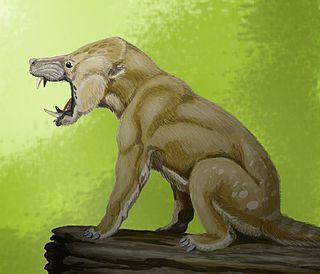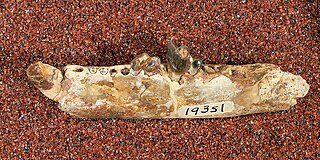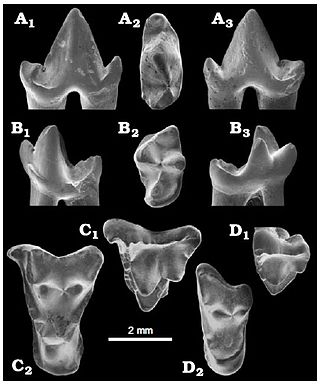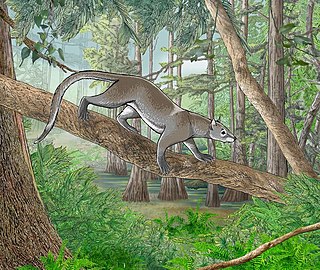Hainina is an extinct mammal genus from the latest Cretaceous to the Paleocene of Europe.
Boffius is a genus of mammal from the Paleocene of Europe, which was named by Vianey-Liaud M. in 1979. It is a member of the extinct order of Multituberculata.

Viverravidae is an extinct monophyletic family of mammals from extinct superfamily Viverravoidea within the clade Carnivoramorpha, that lived from the early Palaeocene to the late Eocene in North America, Europe and Asia. They were once thought to be the earliest carnivorans and ancestral to extant ones, but now are placed outside the order Carnivora based on cranial morphology as relatives to extant carnivorans.

Arctocyonidae has been defined as an extinct family of unspecialized, primitive mammals with more than 20 genera. Animals assigned to this family were most abundant during the Paleocene, but extant from the late Cretaceous to the early Eocene . Like most early mammals, their actual relationships are very difficult to resolve. No Paleocene fossil has been unambiguously assigned to any living order of placental mammals, and many genera resemble each other: generalized robust, not very agile animals with long tails and all-purpose chewing teeth, living in warm closed-canopy forests with many niches left vacant by the K-T extinction.

Tapocyon is an extinct genus of placental mammals from clade Carnivoraformes, that lived in North America during the middle Eocene. Tapocyon was about the size of a coyote and is believed to have been a good climber that spent a lot of time in trees.

Uintacyon is an extinct paraphyletic genus of placental mammals from clade Carnivoraformes, that lived in North America from early to middle Eocene.

Vassacyon is an extinct genus of placental mammals from clade Carnivoraformes, that lived in North America and Europe from late Paleocene to early Eocene. It is considered the largest of the early Eocene mammals.

Procynodictis is an extinct genus of placental mammals from clade Carnivoraformes, that lived in North America from early to middle Eocene.

Tillodontia is an extinct suborder of eutherian mammals known from the Early Paleocene to Late Eocene of China, the Late Paleocene to Middle Eocene of North America where they display their maximum species diversity, the Middle Eocene of Pakistan, and the Early Eocene of Europe. Leaving no descendants, they are most closely related to the pantodonts, another extinct group. The tillodonts were medium- to large-sized animals that probably feed on roots and tubers in temperate to subtropical habitats.

Adapisoriculidae is an extinct family of non-placental eutherian mammals present during the Paleogene and possibly the Late Cretaceous. They were once thought to be members of the order Erinaceomorpha, closely related to the hedgehog family (Erinaceidae), because of their similar dentition, or to be basal Euarchontans. They were also thought to be marsupials at one point. Most recent studies show them to be non-placental eutherians, however.

Gracilocyon is an extinct paraphyletic genus of placental mammals from clade Carnivoraformes, that lived in North America and Europe from late Paleocene to early Eocene.
Dawsonicyon is an extinct genus of placental mammals from clade Carnivoraformes, that lived in North America from early to middle Eocene. Fossils of type species Dawsonicyon isami are known from the ‘Bridger B’, site of Black’s Fork member of the Bridger Formation in Wyoming, and includes an almost complete skeleton.

Umayodus is an extinct genus of "condylarth" mammal from the late Paleocene or the earliest Eocene. It is a didolodontid which lived in what is now Peru. It is known from the holotype LU3-801, an isolated right third molar, which was found in the Muñani Formation of Laguna Umayo, Peru. It was first named by Javier N. Gelfo and Bernard Sigé in 2011 and the type species is Umayodus raimondi.
Deccanolestes is a scansorial, basal Euarchontan from the Late Cretaceous (Maastrichtian) and Paleocene Intertrappean Beds of Andhra Pradesh, India. It may be closely related to Sahnitherium. Deccanolestes has been referred to Palaeoryctidae in the past, but recent evidence has shown that it is either the most basal Euarchontan, as the earliest known Adapisoriculid, or as a stem-afrotherian.
Afrodon is an extinct genus of eutherians in the family Adapisoriculidae. Its type species is Afrodon chleuhi, known from the late Palaeocene of Morocco. The other known species are Afrodon germanicus from the late Palaeocene of Germany and France, Afrodon tagourtensis from the early Eocene of Morocco, Afrodon ivani from the late Palaeocene of Spain, and Afrodon gheerbranti from the early Paleocene of Belgium. Its range spread from the Cernaysian to the Grauvian in the European land mammal ages.

Bustylus is an extinct genus of eutherians in the family Adapisoriculidae. It was described by Emmanuel Gheerbrandt and Russell in 1991, and the type species is B. cernaysi, described from the late Paleocene of Cernay, France, and possibly also from Germany. Gheerbrandt later redescribed the species Peradectes marandati as a species of Bustylus. A third species, B. folieae, was described from the early Paleocene of Belgium by Eric De Bast, Bernard Sigé and Thierry Smith in 2012. B. folieae was named in honour of Dr. Annelise Folie.

Dormaalocyon is an extinct genus of placental mammals from clade Carnivoraformes, that lived in Europe during early Eocene. Type species, Dormaalocyon latouri was discovered when fossils were unearthed in the village of Dormaal, near Zoutleeuw, in the Belgian province of Flemish Brabant.
Wyonycteris is a genus of small mammals that existed in the late Paleocene and early Eocene epochs. The type species is Wyonycteris chalix, which lived in Wyoming during the Clarkforkian North American Land Mammal Age of the Paleocene and was originally proposed to be an early form of insectivorous bat. Later re-examination of the material has put this alliance in doubt, and the genus has instead been proposed as belonging to the subfamily Placentidentinae, within the family Nyctitheriidae. Similar fossil material of the same time period found in Europe was later discovered and described as new species, Wyonycteris richardi.
Chiromyoides is a small plesiadapid primatomorph that is known for its unusually robust upper and lower incisors, deep dentary, and comparatively small cheek teeth. Species of Chiromyoides are known from the middle Tiffanian through late Clarkforkian North American Land Mammal Ages (NALMA) of western North America, and from late Paleocene deposits in the Paris Basin, France.

Arctocyonians are a clade of laurasiatherian mammals whose stratigraphic range runs from the Palaeocene to the Early Eocene epochs. They were among the earliest examples of major mammalian predators after the Cretaceous–Paleogene extinction event. While some classify arctocyonians as stem-artiodactyls, others have classified the group as members of Ferae. There are three families classified in the order: Arctocyonidae, Oxyclaenidae, and Quettacyonidae.











